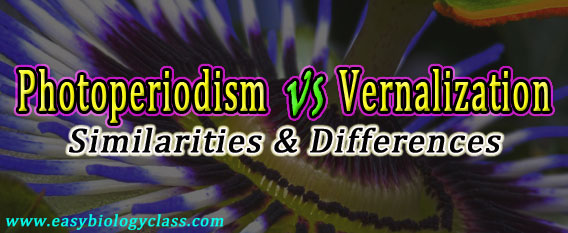Photoperiodism vs Vernalization

Ø Both Photoperiodism and Vernalization are physiological process in plants.
Ø Both influence the flowering in plants.
Ø Both processes are mediated through plant hormones.
Ø Both can occur naturally or artificially.
Ø Both have agricultural applications.
You may also like NOTES in...
BOTANY BIOCHEMISTRY MOL. BIOLOGY
ZOOLOGY MICROBIOLOGY BIOSTATISTICS
ECOLOGY IMMUNOLOGY BIOTECHNOLOGY
GENETICS EMBRYOLOGY PHYSIOLOGY
EVOLUTION BIOPHYSICS BIOINFORMATICS
Difference between Photoperiodism and Vernalization
Sl. No. Photoperiodism Vernalization
1 Photoperiodism is the induction of flowering in plants by exposing them to appropriate photoperiods (light and dark periods). Vernalization is the process of induction of flowering in plants by exposing them to cold temperature.
2 Photoperiodism provides both the stimuli and the induction of flowering. Vernalization only prepares the plant for perceiving the flowering stimuli. It does not induce flowering.
3 The stimuli induced by light in photoperiodism are received only by the green leaves. The stimuli induced by the cold treatment in the vernalization are received by leaves, meristem and embryos.
4 The photoperiodism is mediated through a hypothetical hormone called Florigen. Vernalization is mediated through a hypothetical hormone vernalin which is known to induce the synthesis of florigen in plants.
5 The exposure of 2 to 3 appropriate photoperiods is enough to induce flowering in plants. The exposure to low temperature (below -2oC to 12oC) for about 50 days is needed to induce flowering through vernalization.
6 Photoperiodic induction cannot be nullified or reverted by exposure to unfavorable photoperiods. Vernalized plants can be devernalized by exposing them to high temperature (40oC).
7 Gibberellic Acid (GA) can replace the exposure to long photoperiods in long-day plants only. GA can replace cold treatment to induce vernalization in all plants.
<< Back to Plant Physiology Notes Page
You might also like…
@. Difference between Phototropism and Photoperiodism
@. Physiological Effects of Auxins vs Gibberellins (GA)
@. Physiological Effects of Gibberellins (GA) vs Abscisic Acid (ABA)
@. Short Day Plants vs Long Day Plants
More Plant Physiology Lecture Notes…
